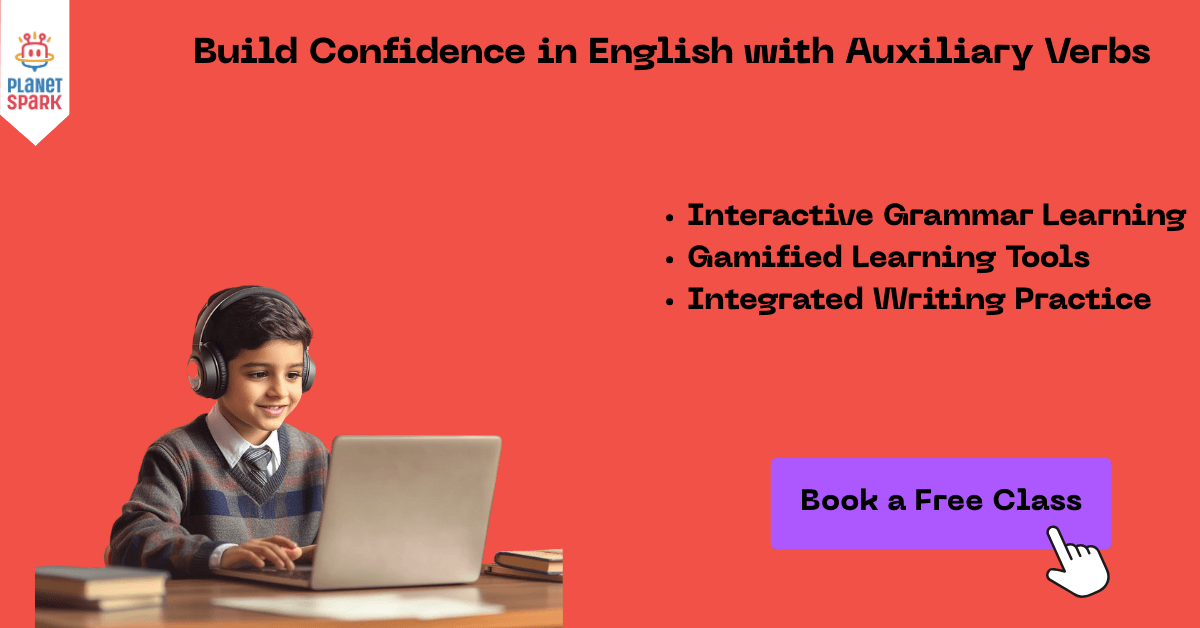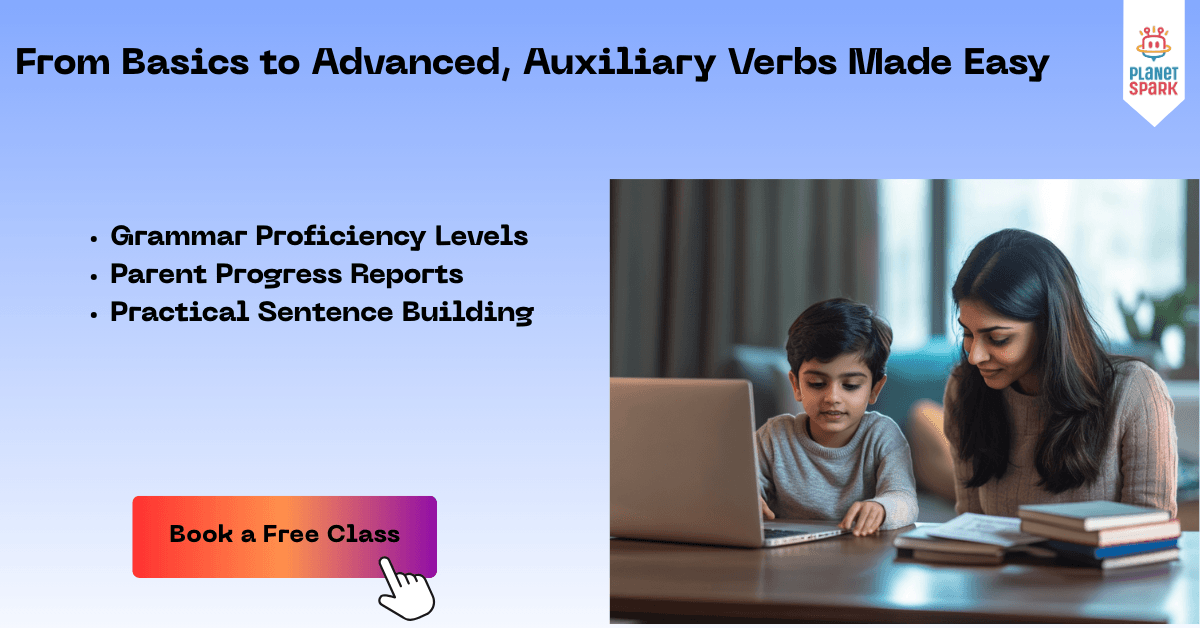Types of Auxiliary Verbs in English Grammar Explained

When we talk about English grammar, most learners immediately think about nouns, verbs, and adjectives. While these are indeed important, one group of words often goes unnoticed, even though it plays a vital role in shaping sentences: auxiliary verbs.
Auxiliary verbs, also known as helping verbs, are the invisible force behind many of the complex structures in English. Without them, it would be nearly impossible to form questions, negatives, compound tenses, or the passive voice. For instance, if you want to say “I have completed my homework” instead of just “I completed my homework”, you need the auxiliary verb have.
In this blog, we will explore the different types of auxiliary verbs, why they are important, how they are used, and how learners can avoid common mistakes. We’ll also introduce you to PlanetSpark’s modern, interactive approach to teaching grammar, where children don’t just memorize rules but use auxiliary verbs through stories, speech practice, writing tasks, and gamified exercises.
By the end, you’ll not only understand auxiliary verbs better but also learn how to master them with confidence.
What Are Auxiliary Verbs?
Auxiliary verbs are verbs that support the main verb in a sentence. While the main verb tells us the action (like eat, run, play), the auxiliary verb adds grammatical meaning such as time, mood, possibility, or voice.
Examples:
She is reading a book. (is helps form the continuous tense)
They have finished their dinner. (have helped form the perfect tense)
Do you like ice cream? (does help form a question)
Unlike main verbs, auxiliary verbs cannot usually stand alone to carry the main meaning of the sentence. Their role is to modify and assist.
Why Are Auxiliary Verbs Important?
Auxiliary verbs are important because they:
Help in tense formation
She has gone home. (Present Perfect)
He is working now. (Present Continuous)
Form questions
Do you like cricket?
Is he coming today?
Make negatives
They do not agree.
She is not ready.
Create the passive voice.
The letter was written by her.
The movie was directed by Nolan.
Express mood, possibility, or necessity
You must wear a helmet.
She might join us later.
Without auxiliary verbs, English sentences would sound incomplete and confusing.

Types of Auxiliary Verbs
There are three main types of auxiliary verbs in English grammar:
Primary Auxiliaries
Modal Auxiliaries
Semi-Modal Auxiliaries
Let’s look at each type in detail with plenty of examples.
1. Primary Auxiliaries
The primary auxiliaries are be, have, and do.
These are the most common helping verbs and are used for:
Forming tenses
Creating negatives
Asking questions
Making passive sentences
a) The Verb Be
Forms: is, am, are, was, were, being, been
She is playing in the park. (Present Continuous)
They were invited to the wedding. (Passive voice)
b) The Verb Have
Forms: has, have, had
I have eaten breakfast already. (Present Perfect)
She had finished the exam before the time. (Past Perfect)
c) The Verb Do
Forms: do, does, did
Do you know the answer? (Question)
She does not like pizza. (Negative)
I did call you yesterday. (Emphasis)
Key Note: Primary auxiliaries can also act as main verbs.
I have a book. (have = main verb)
I have completed my work. (have = auxiliary)
2. Modal Auxiliaries
Modal verbs express ideas such as possibility, ability, obligation, necessity, or certainty.
The common modal auxiliaries are:
Can, could, may, might, shall, should, will, would, must, ought to
Examples of Usage:
Ability: She can swim very fast.
Possibility: It might rain tomorrow.
Obligation: You must complete the assignment.
Advice: You should drink more water.
Future: He will join the meeting.
Rule: Modal verbs are always followed by the base form of the main verb.
She can sings. (Incorrect)
She can sing. (Correct)
3. Semi-Modal Auxiliaries
Semi-modal auxiliaries behave partly like modal verbs but also share features with main verbs.
The common ones are:
need
dare
used to
have to
Examples:
You need not worry. (auxiliary)
He dare not speak in front of the teacher.
I used to play cricket every Sunday.
I have to submit my homework by tonight.
These verbs often confuse learners because they sometimes behave like full verbs and sometimes like auxiliaries.

Common Mistakes with Auxiliary Verbs
Learners frequently make the following mistakes:
Using the wrong auxiliary verb
She do not like it. (Incorrect)
She does not like it. (Correct)
Leaving out auxiliaries in questions
You like pizza? (Incorrect)
Do you like pizza? (Correct)
Adding -s or -ed to modal verbs
He cans swim. (Incorrect)
He can swim. (Correct)
Using unnecessary double auxiliaries
He does can play the guitar. (Incorrect)
He can play the guitar. (Correct)
Practice Exercises
Fill in the blanks with the correct auxiliary verb:
She ___ (is/are) writing a letter.
They ___ (have/has) already arrived.
You ___ (must/should) wear a helmet.
He ___ (do/does) not like sweets.
Answers:
is
have
must
does
How PlanetSpark Helps Children Master the Types of Auxiliary Verbs
At PlanetSpark, learning auxiliary verbs isn’t about memorizing dry grammar charts, it’s about real usage in speaking, writing, and storytelling.
Here’s how we do it with our powerful ecosystem:
1. 1:1 Personal Trainers for Every Child
Every student is matched with a certified communication expert who delivers live, one-on-one classes. Trainers focus on grammar (including types of auxiliary verbs), storytelling, public speaking, creative writing, and fluency. They understand each child’s pace, give instant feedback, and build a strong mentor-child connection.
2. Personalised Curriculum and Learning Roadmap
We start with an assessment, identify gaps in grammar, fluency, and confidence, and then create a customised roadmap. This roadmap evolves with progress and ensures structured mastery of auxiliary verbs and beyond.
3. SparkX – AI-Enabled Video Analysis
Students upload speeches or storytelling tasks. SparkX analyses grammar usage (including auxiliary verbs), voice clarity, confidence, and stage presence. Parents receive easy-to-read reports highlighting strengths and areas for improvement.
4. AI-Led Practice Sessions
Kids practise speeches, grammar, and storytelling with a virtual AI coach. They receive instant feedback on voice, fluency, grammar (auxiliary verbs included), and pacing.
5. Spark Diary – Writing Practice
A digital journal where kids practise daily writing: stories, essays, reflections. Trainers give prompts like: Write a paragraph using modal auxiliaries such as “can, must, should.” This reinforces grammar through real writing.
6. Gamified Learning Modules
Kids engage in Grammar Guru Challenge, Word Wisdom, and Antonyms Quiz. Auxiliary verbs become fun through quizzes, daily practice, and interactive games.
7. Structured Parent-Teacher Meetings
Parents stay updated with grammar progress reports, including insights on auxiliary verb mastery.
8. Comprehensive Progress Reports
Reports evaluate grammar and syntax, body language, fluency, and creative writing. Auxiliary verbs are tracked as part of grammatical growth.
9. Learning Clubs and Communities
Children practise grammar in real-world contexts:
Debate Club – Using modal verbs for arguments (“We must act now!”)
Story Writing Club – Using semi-modals (“He used to play cricket.”)
Speech Circles – Perfecting auxiliary use in public speaking.
10. Sparkline – Safe Content Sharing
Kids post their stories, speeches, and writing pieces that demonstrate auxiliary verb usage.
11. Contests and Recognition
Grammar-based contests, writing challenges, and open mics give real opportunities to use auxiliary verbs in practice.
12. SparkBee and SparkShop
SparkBee: Daily quizzes and grammar challenges on auxiliary verbs.
SparkShop: Digital eBooks covering grammar, vocabulary, and writing.
With PlanetSpark, children don’t just learn the types of auxiliary verbs, they master them through speaking, writing, feedback, and gamified practice.
Conclusion
Auxiliary verbs may seem small, but they play a powerful role in communication. They help us:
Create correct tenses
Form questions and negatives
Express possibilities, abilities, and obligations
Construct passive sentences
To summarize the types of auxiliary verbs:
Primary Auxiliaries: be, have, do
Modal Auxiliaries: can, could, may, might, shall, should, will, would, must, ought to
Semi-Modal Auxiliaries: need, dare, used to, have to
Mastering them is key to speaking and writing English fluently.
FAQs on Types of Auxiliary Verbs
1. What are auxiliary verbs in English grammar?
Auxiliary verbs are helping verbs used with main verbs to form tenses, questions, negatives, and passive voice.
2. How many types of auxiliary verbs are there?
There are three main types: Primary Auxiliaries, Modal Auxiliaries, and Semi-Modal Auxiliaries.
3. What is the difference between main verbs and auxiliary verbs?
Main verbs carry the primary meaning of the sentence, while auxiliary verbs help express tense, mood, or voice.
4. Can a verb be both a main verb and an auxiliary verb?
Yes. Example: I have a book (main verb) vs I have eaten lunch (auxiliary verb).
5. What are examples of modal auxiliary verbs?
Examples include: can, could, may, might, shall, should, will, would, must, ought to.
6. Are “need” and “dare” considered auxiliary verbs?
Yes, they are semi-modal auxiliaries when used in forms like You need not worry or He dare not argue.
7. How does PlanetSpark help children master auxiliary verbs?
PlanetSpark combines 1:1 live classes, AI tools, gamified modules, and writing practice to ensure children understand and use the types of auxiliary verbs confidently.
Personalized Communication Report
Record a video to get a AI generated personalized communication report for your child

Hi There, want to try these
tips for your child with
LIVE with our expert coach?
Let's check your child's
English fluency
